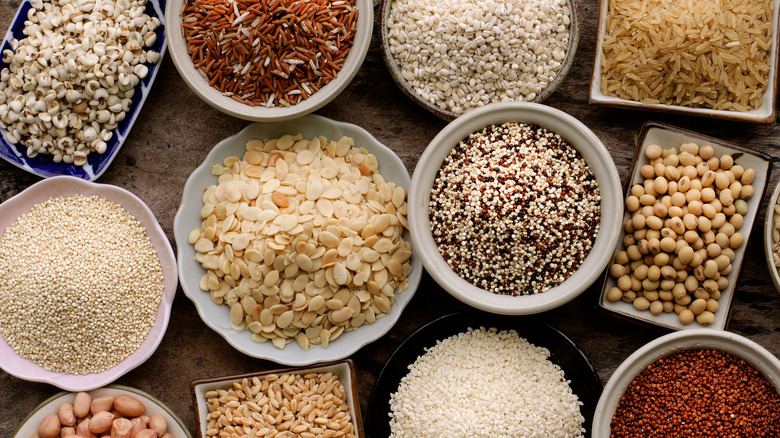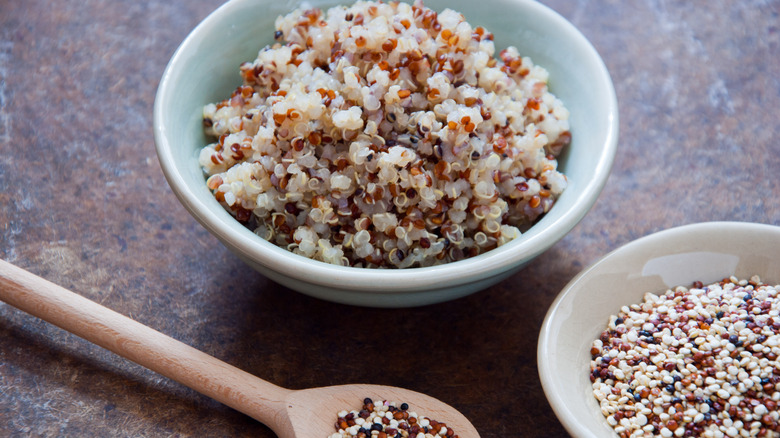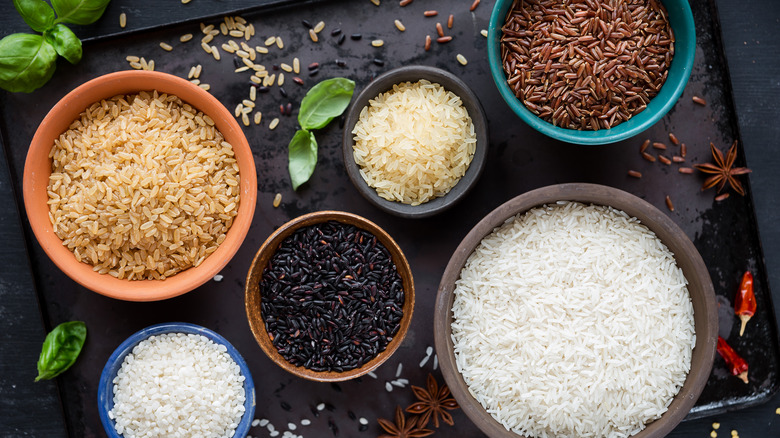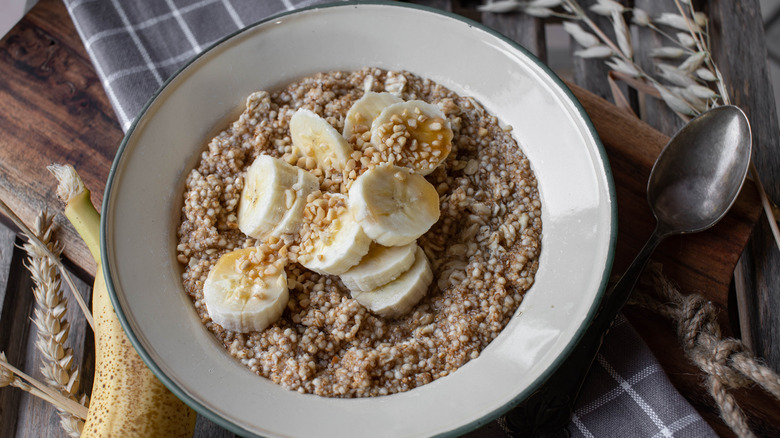Which One Is Healthier: Quinoa Or Rice? Turns Out The Answer Is Pretty Complex
Touted as the "supergrain of the future," quinoa is popular among health enthusiasts worldwide. This pseudo-cereal has been around for about 5,000 years and comes in more than 120 varieties, according to the Harvard T.H. Chan School of Public Health. What few people are aware of is that quinoa is actually a seed, not a grain, but it can be used the same way you'd use rice, wheat, barley, and other cereals.
Speaking of rice, how does it compare to quinoa? Is it more nutritious? The answer depends on several factors, including the type of rice and how it's cooked. "Black rice has been shown to have the highest antioxidant activity of all the rice varieties," dietitian Marisa Moore, MBA, RDN, said to Women's Health. "It gets its deep purple-black color from anthocyanins, the same pigments that give blackberries their antioxidant power."
Brown rice and other whole rice varieties are chock-full of fiber, minerals, and antioxidants, too. White rice is highly processed and, therefore, less nutritious, but it still has its place in a healthy diet. With that in mind, you may be wondering whether you should swap rice for quinoa — or the other way around. Although these grains are interchangeable in most recipes, each has a distinct nutritional profile.
Quinoa, a powerhouse of protein and fiber
Did you know that quinoa is a complete protein? According to the Harvard T.H. Chan School of Public Health, this ancient grain contains all nine essential amino acids. Plus, it's rich in magnesium, thiamin, folate, and other key nutrients. One cup of cooked quinoa has around 8 grams of protein, 3.6 grams of fat, and 39 grams of carbs, including more than 5 grams of fiber. It also boasts a whopping 22% of the recommended daily phosphorus intake, plus large doses of calcium, iron, zinc, copper, selenium, and manganese.
Moreover, quinoa contains polyphenols and other antioxidants that may protect against heart disease, diabetes, and cancer, notes a 2020 review published in the journal Foods. Additionally, one cup of quinoa provides about 20% of the recommended daily intake of fiber, a nutrient that aids in digestion, says the University of Michigan. High-fiber foods may help improve glycemic control and blood lipids, reduce inflammation, and boost cardiovascular health.
This "supergrain" is also gluten-free, but you should still check the label to ensure it's not cross-contaminated with wheat or other gluten-containing grains. Apart from that, its high protein content supports muscle growth and repair, enzyme production, fat loss, and endocrine function. "Protein plus fiber keeps us full longer, which means you don't feel the urge to eat as often. This helps keep weight down while fueling our cells with the right nutrients they need," chef Nancy Waldeck said to Piedmont Healthcare.
Some rice varieties are chock-full of nutrients
Not all rice is created equal. Some varieties are chock-full of fiber, antioxidants, and trace minerals, whereas others have little nutritional value. For example, the so-called forbidden rice, or black rice, boasts around 5 grams of protein and 34 grams of carbs, including 2 grams of fiber, per cup (cooked). What makes it stand out is its antioxidant content, reports a 2016 study featured in the American International Journal of Research in Formal, Applied, and Natural Sciences. This grain is rich in anthocyanins, flavonoids, vitamin E, and other compounds that fight oxidative damage and inflammation.
In clinical trials, black rice has been shown to facilitate weight loss, lower heart disease risk, and protect against diabetes. Iron, one of its most abundant nutrients, may help prevent anemia, while the outer husk of the rice inhibits histamine production, which may help reduce allergies. Research also suggests that black rice can boost eye health, digestive function, and bone strength.
Brown and wild rice are nutritious, too, offering more than 3 grams of fiber per cup. Cooked white rice has around 6.5 grams of protein per cup, whereas the same amount of brown rice boasts 4.5 grams of protein. Both rice varieties are rich in calcium, potassium, phosphorus, magnesium, and B-complex vitamins. By comparison, white rice is much lower in protein, fiber, magnesium, zinc, and potassium but higher in iron. Also, note that plain rice, regardless of its color, is gluten-free.
Quinoa has a slight nutritional advantage over rice
Quinoa is a whole grain, but so is black, brown, or wild rice. However, quinoa seeds are higher in protein, fiber, and some minerals. For example, a cup of cooked quinoa has nearly twice as much protein as brown rice, plus significantly larger amounts of iron, potassium, calcium, magnesium, and folate. Brown rice, on the other hand, is higher in niacin, manganese, and vitamin B6.
Niacin, or vitamin B3, plays a key role in energy metabolism, enzyme production, and DNA synthesis, notes the Harvard T.H. Chan School of Public Health. Brown rice also delivers 93% of the recommended daily allowance of manganese, a mineral that supports bone growth, glucose metabolism, blood clotting, and immune function, according to the National Institutes of Health (NIH). Vitamin B6, one of the key nutrients in brown rice, contributes to more than 100 enzyme reactions and supports cognitive function, according to the NIH.
Given these aspects, it's fair to say that both grains have their place in a balanced diet. Quinoa is more nutritious overall, but whole rice is healthy, too. However, there's no need to choose between the two. You could start your day with a bowl of rice and bacon or scrambled eggs, snack on a crispy quinoa bite recipe between meals, and use either grain in your go-to recipes. It's your overall diet that matters most.



